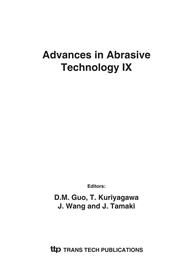[1]
E.O. Ezugwu, High spped machining of Aero-Engine alloys, J. of the Braz. Soc. of Mech. Sci. & Eng., 2004, Vol. XXVI, No. 1, pp.1-11.
DOI: 10.1590/s1678-58782004000100001
Google Scholar
[2]
V.C. Venkatesh, S. Rajesham, V. Kamala, Wear and surface finish in face-milling with rotary inserts, Proceedings of Fifth AIMTDR Conference (1972).
Google Scholar
[3]
E.J.A. Armarego, V. Karri, A.J.R. Smith, Fundamental studies of driven and self-propelled rotary tool cutting process-I theoretical investigation, International of Journal of Machine Tool Manufacture 34 (6) (1994) 785-801.
DOI: 10.1016/0890-6955(94)90059-0
Google Scholar
[4]
E.J.A. Armarego, V. Karri, A.J.R. Smith, Fundamental studies of driven and self-propelled rotary tool cutting process-II theoretical investigation, International of Journal of Machine Tool Manufacture 34 (6) (1994) 803-815.
DOI: 10.1016/0890-6955(94)90060-4
Google Scholar
[5]
S.S. Joshi, N. Ramakrishnan, H.E. Nagarwalla, P. Ramakrishnan, Wear of rotary carbide tools in machining of Al/SiCp composites, Wear 230 (1999) 124-132.
DOI: 10.1016/s0043-1648(99)00092-7
Google Scholar
[6]
H.A. Kishawy, J. Wilcox, Tool wear and chip formation during hard turning with self-propelled rotary tools, Int. J. of Machine Tools and Manufacture 43 (4) (2003) 433-439.
DOI: 10.1016/s0890-6955(02)00239-0
Google Scholar
[7]
T. Warren Liao, Clustering of time series data-a survey, Pattern Recognition, Volume 38, Issue 11, 2005, pp.1857-1874.
DOI: 10.1016/j.patcog.2005.01.025
Google Scholar
[8]
Eric J. Kostelich, The analysis of chaotic time-series data, Systems & Control Letters, Volume 31, Issue 5, 1997, pp.313-319.
DOI: 10.1016/s0167-6911(97)00045-5
Google Scholar
[9]
X. Liu and K. Cheng, Modelling the machining dynamics of peripheral milling, Int. J. of Machine Tools and Manufacture, Vol 45, Issue 11, 2005, pp.1301-1320.
DOI: 10.1016/j.ijmachtools.2005.01.019
Google Scholar
[10]
S.Z. Yang, Engineering application of time series analysis, The Huazhong University of Science and Technology Press, Wuhan, 1992(in Chinese).
Google Scholar


